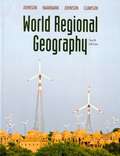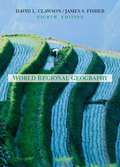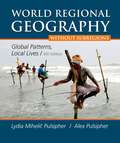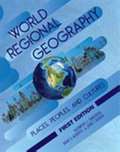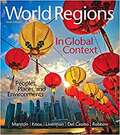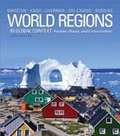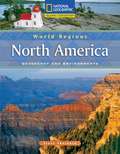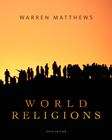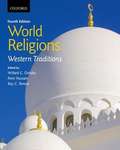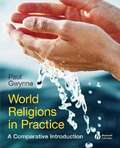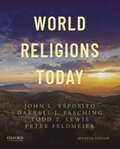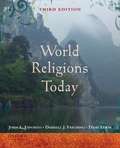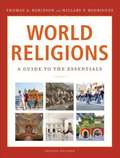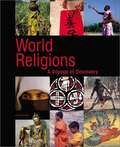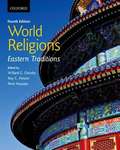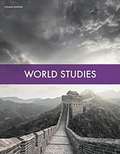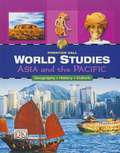- Table View
- List View
World Regional Geography (10th edition)
by David L. Clawson Merrill L. Johnson Douglas L. Johnson Viola HaarmannPulling from an impressive team of ten authors, each chapter in this book has been authored by an expert in the region to provide the utmost accuracy and relevancy. World Regional Geography explores the character of the world's people, with a central theme of human development, for an issues-oriented overview of each region. An emphasis on subregions (places within regions) enables readers to explore specific locales. An economic development theme offers a more conceptual treatment than the traditional coverage of this topic. Basic Concepts and Ideas; The United States and Canada; Latin America and the Caribbean; Europe; Northern Eurasia; Central Asia and Afghanistan; The Middle East and North Africa; Africa South of the Sahara; South Asia; East Asia; Southeast Asia; Australia, New Zealand, and the Pacific Islands. The useful references for anyone who wants to learn more about the different regions of the world.
World Regional Geography: A Development Approach (8th edition)
by David L. Clawson Merrill L. JohnsonThis book is organized around the central theme of human development. Each author employs the human development theme to create a substantive volume on world regional geography that presents a vital, issues-oriented overview of the topic.
World Regional Geography: Global Patterns, Local Lives (Without Subregions) (Sixth Edition)
by Lydia Mihelic Pulsipher Alex A. Pulsipher Conrad Mac" GoodwinThe main goal of this book is to make global patterns of trade and consumption meaningful for students by showing how these patterns affect not only world regions but also ordinary people at the local level.
World Regional Geography: Places, Peoples, and Cultures
by Kazimierz ZaniewskiWorld Regional Geography: Places, Peoples, and Cultures provides students with a fresh approach to the study of world geography through a topical exploration of ten major world regions. The text explores the landscapes and societies on Earth in order to appreciate the environmental diversity of the planet and the cultural richness of humanity from the interdisciplinary perspective of geography. The book is richly illustrated with maps, photos, and graphs. <p><p> The book begins with a chapter introducing students to the geographic perspectives used to study places, people, and culture, including physical environment, human-environment interaction, population patterns and trends, systems of communication, systems of belief, political organization of space, and economic activities. Subsequent chapters build upon this knowledge and framework to help students explore North America, Europe, the Russian Realm, Southwestern Asia and Northern Africa, Sub-Saharan Africa, Latin America, East Asia, South Asia, Southeast Asia, and Australia and Oceania. Students study demographics, religion, linguistics, politics, agriculture, tourism, foreign and domestic policy, and more as they travel the world. <p> In reading World Regional Geography, students gain a deeper understanding of the rich geography and cultural traditions of major regions around the globe. It is an excellent resource for undergraduate courses in geography, international studies, and related fields.
World Regions In Global Context: Peoples, Places, And Environments
by Paul Robbins Paul Knox Vincent Del Casino Sallie Marston Diana LivermanWorld Regions in Global Context presents a strong global sensibility and an emphasis on current events, with examples of interdependent development, spatial and social inequality, and questions of spatial justice. The authors maintain that regions are the outcomes of the twin forces of globalization and regionalization. Therefore, each regional chapter stresses the global systems of connection that drive unique regional processes, making regions different. By studying regions, students not only learn the critical elements of different places, but also come to understand the fundamental processes that drive change. <p><p> The Sixth Edition is a briefer, more visual text that still maintains its conceptual rigor by addressing today’s critical geographic themes, incorporating deeper focus on sustainability issues, new human stories from the regions, cutting-edge data visualizations and infographics, including a completely modernized cartography program, and much more.
World Regions in Global Context: Peoples, Places, and Environments (5th Edition)
by Sallie A. Marston Paul L. Knox Diana M. Liverman Vincent J. Del Casino Paul F. RobbinsThe author provides a framework for understanding the global connections that affect the dynamic and complex relationships between people and the worlds they inhabit.
World Regions: North America Geography and Environments
by Steve SheinkinSocial Studies textbook for primary grade students. Part of Reading Expeditions series.
World Religions
by Warren MatthewsPresenting both the histories and the prevalent worldviews of the major world religions, Matthews's WORLD RELIGIONS, Sixth Edition, methodically introduces the richness and diversity of these traditions. The "Worldview" sections in particular make this book helpful for comparative analyses of the religions. These sections show how the different religions approach a common set of ten themes that are fundamental to all traditions, including the nature of the Absolute, the place of humans in the world, rituals and symbols, and the prospects for life after death. Furthermore, this text combines insightful, engaging prose with maps, photographs, timelines, excerpts from sacred texts, and other helpful pedagogical aids that provide a comprehensive yet accessible survey of world religions.
World Religions (Fourth Edition): Western Traditions
by Amir Hussain Willard G. Oxtoby Roy C. AmoreFeaturing work from expert contributors, World Religions: Western Traditions, Fourth Edition, provides students with an authoritative examination of Jewish, Christian, Muslim, ancient, indigenous, and new traditions. Accessible and engaging, this acclaimed text explores the origins, central teachings, divisions and branches, rituals and practices, influences on culture, and responses to modern challenges for each tradition.
World Religions In Practice: A Comparative Introduction
by Paul GwynneA major new textbook exploring the world's great religions through their customs, rituals and everyday practices by focusing on this 'lived experience' it goes beyond many traditional introductions to religious studies. Adopts a directly comparative approach to develop a greater understanding of the nature of religion. Each chapter engages with an individual theme, such as birth, death, food, pilgrimage and ethics, to illustrate how religious practices are expressed. Broadens students' understanding by offering an impartial discussion of the similarities and differences between each religion.
World Religions Today
by John Esposito; Darrell J. Fasching; Todd T. Lewis; Peter FeldmeierRevealing the significance of religion in contemporary life, World Religions Today, Seventh Edition, explores major religious traditions--Judaism, Christianity, Islam, Hinduism, Buddhism, South Asian religions, East Asian religions, indigenous religions, and new religions--as dynamic, ongoing forces in the lives of individuals and in the collective experience of modern societies. This unique volume accomplishes two goals: it connects today's religions to their classical beliefs and practices and focuses on how these religions have both radically changed the modern world and been changed by it. The book is enhanced by numerous pedagogical aids--text boxes, timelines, maps, illustrations, discussion questions, a comprehensive glossary of key terms, and suggestions for further reading--and more than 200 photographs.
World Religions Today (3rd Edition)
by John L. Esposito Darrell J. Fasching Todd LewisThis textbook, designed for the first university survey course on the major world religions, focuses on the effect of modernity on world religions: what their adherents practise as well as the way the faiths developed historically and includes full instructor and student supports.
World Religions: A Guide to the Essentials
by Thomas A. Robinson; Hillary P. RodriguesThis masterful survey of world religions presents a clear and concise portrait of the history, beliefs, and practices of Eastern and Western religions. The new edition contains added material and has been revised throughout. The authors, both respected scholars of world religions, have over fifty years of combined teaching experience.
World Religions: A Voyage of Discovery
by Jeffrey BroddThe Ad Hoc Committee to Oversee the Use of the Catechism has judged that the text falls outside the scope of the types of materials they review for conformity to the Catechism.* <p><p> "Why do Muslims face Mecca to pray? Why do Buddhists chant?" The major religions of the world are a mystery to many high school teens. Now you can help them unlock the doors of these traditions with our new text, World Religions: A Voyage of Discovery. The book is an introductory survey that helps eleventh and twelfth graders understand the people, dimensions, and religious principles of the world's major religions. <p><p>The textbook includes a chapter on each of eleven major world religions, including Christianity, Islam, Hinduism, Buddhism, Judaism, and others. The text offers the Catholic perspective on interreligious dialogue, an overview of basic questions that religions address, and Ninian Smart's seven dimensions of religion. A glossary and word pronunciations in each chapter help students learn unfamiliar terms. <p><p> In addition, the second edition of this text incorporates the following new features: <ul> <li>a new chapter on modern trends in religion new, more detailed maps</li> <li>a new section on the Aztec religion of Mesoamerica</li> <li>a sidebar in each chapter offering examples of the seven dimensions of religion in each chapter</li> <li>review questions at the end of each chapter</li></ul> <p><p> *The Ad Hoc Committee to Oversee the Use of the Catechism reviews only materials which are catechetical in nature and which teach the beliefs, practices, and doctrine of the Catholic Faith. World Religions falls outside the scope of the types of materials the Committee reviews. This text outlines the basic beliefs and practices of the major religions of the world, taking a comparative approach, as do most texts on this topic, to identify the distinctive elements of the various religions. <p><p> This edition of World Religions, however, also includes a very important forward that introduces "The Roman Catholic Church and Non-Christian Religions," and references documents of the Second Vatican Council. This forward explains the Catholic viewpoint on the importance of learning about and coming to a basic understanding of the other major religions of the world.
World Religions: Eastern Traditions
by Amir Hussain Willard Oxtoby Roy AmoreFeaturing work from expert contributors, World Religions: Eastern Traditions, Fourth Edition, provides students with an authoritative examination of Hinduism, Sikhism, Jainism, Buddhism, and Chinese, Korean, and Japanese religions. Accessible and engaging, this acclaimed text explores the origins, central teachings, divisions and branches, rituals and practices, influences on culture, and responses to modern challenges for each tradition.
World Studies
by Dennis E. BollingerThe BJU Press World Studies 7th Grade curriculum provides students with a stirring, fascinating, chronological narrative of world history that reveals the hand of God at work among the nations. Covering 1,000 A.D. to the present, this text covers the birth of the Church, the rise of Islam, and a survey of world nations. Photos, maps, artwork, section review questions, and engaging margin boxes are integrated throughout. Each chapter ends with a chapter review that asks students to think in terms of higher learning, including understanding, analyzing, and evaluating. 408 pages with index and glossary, softcover. Grade 7.
World Studies (3rd Edition)
by Dennis BollingerWorld Studies Student Text begins with a brief review of history from Creation to the coming of Christ and progresses in a chronological journey around the world studying the ebb and flow of empires, cultures, Christianity, and world religions. It concludes with an examination of the trends of the emerging 21st century.
World Studies - Western Hemisphere: Reading and Vocabulary Study Guide
by Prentice Hall EditorsWorld Studies - Western Hemisphere: Reading And Vocabulary Study Guide
World Studies Activity Manual (3rd Edition)
by Dennis BollingerThis book arms students' further on the history they learn in class. Topics covered are: creation, cultures, dominant powers in Europe & Asia, the revolutionary age and the 20th century & beyond.
World Studies Asia and the Pacific Student Edition
by Prentice HallCustomize your own unique balance of history, geography, and culture with your choice of eight small-book or two full-volume options! Using standards-based content and research-proven reading instruction, World Studies expands students' understanding of each world region through a focus on its major countries. Considerate text design and narrative combine with enhanced reading strategiesâ "such as Target Reading Skills and key terms defined in contextâ "to make lessons accessible to students at all levels. Features and Benefits Interactive maps Lead students to geographic literacy with MapMaster™—the map skills instruction system enhanced with online maps. Research-based reading instruction Integrated reading skills instruction and vocabulary development improve comprehension for all students. Technology that brings content to life Take exciting journeys around the world with over 20 Discovery Channel School ® World Studies video segments per book, integrated at point-of-use. Hands-on activities Geographer's Apprentice Activity Pack presents activities that explore the geography of the world's regions through maps, data, and primary sources.
World Studies for Georgia Students (Sixth Grade)
by Hope Bentley Culpepper Jaime Hollingsworth Emmett R. Mullins Jr. Rebekah BlankenshipYou might wonder why it is important to study other countries in the world. As a person who lives in the state of Georgia in the United States, you do not live very close to any of these other countries. However, Georgians today are connected closely to the whole world. You have goods such as clothing or electronics that have been manufactured in other countries and sold in your state. You may have family members who work for businesses that depend on trade with other countries. You live in a country that works with governments around the world, and the United States military defends our country from sites around the globe. From just about anywhere in Georgia you only have to look in the sky to see more evidence of your state's connections to the world--jets carrying goods and people to faraway destinations. Hartsfield-Jackson Atlanta International Airport is key to these connections. The airport is the world's busiest with more than 900,000 flights carrying over 100,000,000 passengers and nearly 650,000 tons of cargo each year. Millions of these passengers and tons of cargo are traveling to other countries in the world. As a citizen of Georgia in the twenty-first century, you will have many opportunities to connect to the larger world. What you learn in this book will help you as you continue your life's journey.
World Studies for Georgia Students - Grade 7 Workbook
by Robert Conner<p>This new textbook aligns 100% with the Georgia Standards for Excellence and will assist teachers who want their students to learn more and at higher levels of thinking. <p>The book is written in an interesting narrative style and is enhanced with carefully chosen photographs, illustrations, maps, graphs, and charts. Students have the opportunity to engage with informational text and then use the information to clarify and expand their thinking with a variety of ancillary materials. The readability is appropriate for seventh graders, and the array of teacher materials will assist educators with differentiating instruction for all learners.</p>
World Studies for Georgia Students [Grade 7]
by Clairmont PressWorld Studies for Georgia Students Grade 7
